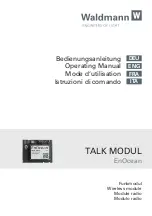
•
TSPEC AP Inactivity Timeout
—
The amount of time for a WAP device to detect a downlink traffic specification
as idle before deleting it. The valid integer range is from 0 to 120 seconds and the default is 30 seconds.
•
TSPEC Station Inactivity Timeout
—
The amount of time for a WAP device to detect an uplink traffic specification
as idle before deleting it. The valid integer range is from 0 to 120 seconds and the default is 30 seconds.
•
TSPEC Legacy WMM Queue Map Mode
—
Check Enable to enable the intermixing of legacy traffic on queues
operating as ACM. By default, this mode is off.
Step 6
Click
OK
and then click
Save
.
Networks
Virtual Access Points (VAPs) segment the wireless LAN into multiple broadcast domains that are the wireless
equivalent of Ethernet VLANs. VAPs simulate multiple access points on one physical WAP device. Up to
four VAPs are supported on this Cisco WAP device.
Each VAP can be independently enabled or disabled, with the exception of VAP0. The VAP0 is the physical
radio interface and remains enabled as long as the radio is enabled. To disable the VAP0, the radio itself must
be disabled.
Each VAP is identified by a user-configured Service Set Identifier (SSID). Multiple VAPs cannot have the
same SSID name. SSID broadcasts can be enabled or disabled independently on each VAP. SSID broadcast
is enabled by default.
SSID Naming Conventions
The default SSID for VAP0 is
ciscosb.
Every additional VAP created has a blank SSID name. The SSIDs for
all VAPs can be configured to other values. The SSID can be any alphanumeric, case-sensitive entry from 2
to 32 characters.
The allowable characters are:
•
ASCII 0x20 through 0x7E.
•
Trailing and leading spaces (ASCII 0x20) are not permitted.
This means that spaces are allowed within the SSID, but not as the first or last character, and the period
“
.
”
(ASCII 0x2E) is also allowed.
Note
VLAN IDs
Each VAP is associated with a VLAN, and is identified by a VLAN ID (VID). A VID can be any value from
1 to 4094, inclusive. This Cisco WAP device supports nine active VLANs (eight for WLAN plus one
management VLAN).
By default, the VID assigned to the configuration utility for the WAP device is 1, which is also the default
untagged VID. If the management VID is the same as the VID assigned to a VAP, then the WLAN clients
associated with this specific VAP can administer the WAP device. If needed, an access control list (ACL)
can be created to disable administration from WLAN clients.
Cisco WAP125 Wireless-AC/N Dual Band Desktop Access Point with PoE
42
Wireless
Networks
















































